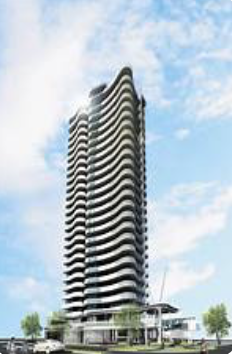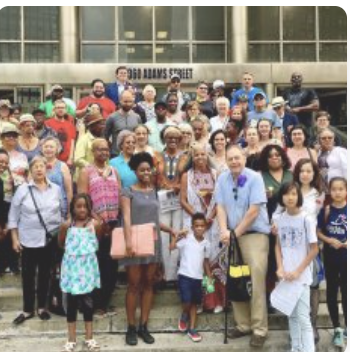
Image above: 25 story building
We are finally getting to another major change happening in our city around development. The removal of the requirement for Developers who want to build up to 25 stories not to perform any type of environmental review.
However, before we can discuss this issue you may need some back ground information to understand this proposal.
Please Note: this is not apart of the City of Yes Economic/Business Text Amendment “COY”. This is a completely separate amendment happening at the same time as COY.
Environmental Reviews
It is New York State Law that any development project that is requesting to change the zoning (how something is built) must conduct an environmental review of the project.
This law is a disclosure law, it does not stop a project if it is determined to be harmful, but does have a component within it that would allow the project to be modified, changed, parts to be eliminated and provide community benefits.
Two Different Reviews.
An Environmental Assessment Statement “EAS” a Short 4 page form to determine if an EIS should be preformed. This is a fast form that was created to reduce the time and money for developers. The form itself takes a few minutes to fill out with the possibility of a few small studies if the project is next to a sensitive ecosystem.
An Environmental Impact Statement “EIS” – If the EAS determines that an EIS must be performed, then a developer must engage in this very intensive environmental review that would require changes to the project, mitigating scenarios to be employed, input from other city agencies, community benefits provided to compensate the community etc..
In order for a project to completely avoid this entire process, it must be classified as Type II. These are normally projects such as a redesign or maintenance project, where it is clear that no new environmental impacts would occur.
The Green Fast Track Amendment
The City is currently asking to add development projects that can go up to 25 stories high and have less than 250 apartments as a Type II project. There are a few situations where a project would not be able to be a Type II depending upon where it is being proposed, including inside landmarked districts, near a public park (not playgrounds) etc..

The Studies
The Department of City Planning “DCP” has made the claim that they conducted a study of over 1,000 applications which showed that no EIS was needed, thus making the EAS an unnecessary burden for developers.
However, MTOPP and Community Boards have asked for the study and even have submitted Freedom of Information Law “FOIL” requests for it but still DCP has refused to provide it to the public!
Others have claimed that over 80% of the 1,000 cases studied pertain to single one and two family homes, which in no way represents the 250 apartments and 25 stories exemption. Also the 25 story height seemed not to make sense, since 250 apartments would be outrageously large to fit into a 25 story building.

The Legal Challenge
DCP has also stated the legal challenges for projects under 25 stories have all failed in the Courts with regards to having to conduct an EIS.
This is not true.
In fact, MTOPP was a part of a lawsuit that pertained to this specific issue, showing that legal challenges have been upheld by a Judicial body.

Above Image: Community residents at the Bklyn Supreme Court. “Boyd vs. Cornell”
ExampleIn Boyd vs. Cornell Realty Management Company, a developer proposed to build two 17/19 story towers containing a total of 390 apartments, along three city blocks bordering the Brooklyn Botanic Garden in a 6/7 story height limited zone. The Community filed a lawsuit against DCP, when it was discovered, via the EAS, that the developers underestimated the number of apartments, to avoid an EIS, showing that over 589 apartments not 390 were going be built, and three towers instead of two. After almost three years and several million dollars later (spent by the Developers, who hired Mayor Adams, former Chief of Staff, Frank Carone as counsel), Judge Boddie, determined in a 29-page decision that in fact, the City failed to conduct a proper environmental review “EIS” and declared the new zoning void. However, with a 100% reversal rate at the Appellant Court, the 2nd Department reversed Judge Boddie’s decision in their 4-page decision which did not contain explanation for their position, declaring that Judge Boddie’s numbers were wrong. The Developers went ahead and built the three towers with 589 residential units, with more apartments coming, showing the ineptitude of the Appellant Department, and not the need to do away with an EAS for apartments that are less than 25 stories high. Just like developers did in this case, they can do again and again: declare a project to have less than 250 apartments, avoid any type of environmental review, and once they get approval they can change the numbers build twice as many or even more apartments. Now the 25 story height limit makes sense.
Developer and the City Learn from Lawsuits Empowers CommunitiesLawsuits can be very effective even if the Appellant Division always sides with the City and Developers regarding legal challenges! For example, because the lawsuit stated above was very costly to Cornell and the Judge Boddie did find in our favor, other proposed projects took heed. They decided not to try to cut corners, but actually conducted an EIS, when proposing a project that was smaller than Cornell’s and right next to it. By taking away our rights to know what is happening in our community and to challenge these proposals, this amendment is meant to disempower us, not to fast track their project!
|
||



0 Comments